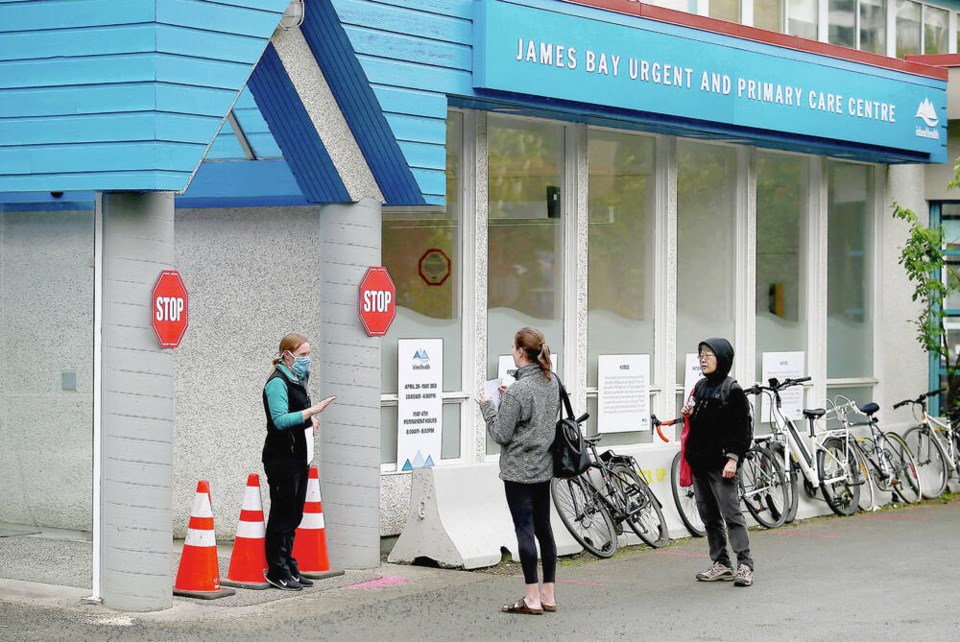As a shortage of doctors and nurses continues to plague the province’s health-care system, the B.C. Liberals have called for an independent audit of what it calls the “worsening dysfunction” of understaffed Urgent and Primary Care Centres.
Health critic Shirley Bond said UPCCs — implemented by the provincial government to take pressure off emergency rooms and provide ongoing care — can’t keep staff, are falling short of their goals to attach patients to family doctors, and are too often at capacity hours after opening.
There are about 27 UPCCs in B.C., including six on the Island. The province hopes to almost double that number by 2025. They employ about 340 full-time equivalent positions.
Introduced in 2018, UPCCs were envisioned as a way to provide access to urgent team-based primary care, along with mental health and addictions services. Open holidays, evenings and weekends, they would offer physicians the flexibility of alternate forms of payment with no overhead.
Health Minister Adrian Dix said in an interview that UPCCs proved critical during the pandemic, providing 1.3 million in-person visits.
“If those UPCCs had not been there during the pandemic, British Columbians would have been worse off, significantly worse off,” said Dix. “They’re part of the response. They were never intended to be the whole response.”
A Health Ministry document for Feb. 4-March 3, 2022, released by the B.C. Liberals, showed James Bay UPCC at 43 per cent of its budgeted staff, West Shore at 37 per cent, North Quadra at 63 per cent, Nanaimo at 34 per cent, Esquimalt at 21 per cent and downtown Victoria at 47 per cent.
Dix said the information is either outdated, “entirely inaccurate” or doesn’t, in some instances, account for doctors who work on a fee-for-service basis — where doctors receive a basic fee of $32 for each patient visit.
As of the most recent report from May, 85 of 134 full-time-equivalent positions budgeted for UPCCs in Island Health are filled, said Dix. He acknowledged it has been difficult to fill positions in the south Island. “All other health authorities are substantially better than that.”
In Nanaimo, arguably the most successful UPCC on the Island, said Dix, the document doesn’t include 36 fee-for-service physicians contributing to the centre there. The West Shore UPCC has a staff complement of 17.8 out of 19.8 full-time-equivalent positions budgeted, said Dix.
By contrast, North Quadra has 13 out of 21. “That’s the place in B.C. where we’ve had the most challenge with family doctors and that’s the place where we’re having the most challenge with UPCCs,” said Dix, who points to centres with full staffing or 70-90 per cent in other parts of B.C.
The Health Ministry says patient visits to Island UPCCs from April 1, 2021 to March 3, 2022 ranged from 13,974 at North Quadra UPCC to 15,614 in James Bay, 17,626 in West Shore and 30,269 in Nanaimo.
Since it opened, the Nanaimo UPCC has had about 100,000 patient visits, while West Shore has had 87,353. “It’s a huge number of patients that have been seen,” said Dix.
In the February budget, the province pegged $57 million over three years in operating costs for an additional 10 urgent and primary care centres in B.C. by 2024-2025, which would bring the total number of UPCCs to 50.
At the same time the province is building out 59 primary-care networks, and is opening community health centres. There are approximately 100 health-authority-run community health centres and 30 community-governed community health centres in B.C.
Some physicians and politicians, however, complain they are too expensive, less efficient, drain private family practices of human and financial resources, and are understaffed.
The Health Ministry released 2021-2022 data that it said showed UPCC physicians averaged 26 in-patient visits per day compared to an average of 22 in-person patient visits per day for family physicians in the community.
B.C. Liberal finance critic Peter Milobar said when the Liberals referred to the March numbers in the last legislative session, the government “amazingly” disputed them “even though they were provided by the minister’s staff.”
“That’s why we’re saying we need to have an independent review, a comprehensive review, to get to the bottom of just how effective or ineffective these urgent and primary care centres are,” said Milobar.
“Are they just simply willing to try to double the number of [UPCCs] because the minister thinks that they’re working versus actually having any data to back up that they are actually working?”
B.C. Green Leader Sonia Furstenau said UPCCs “clearly aren’t working,” but what is working are non-profits such as Shoreline Medical Society, which operates clinics in Sidney and Brentwood Bay, is governed by volunteer board members and is funded primarily by the Saanich Peninsula Hospital and Healthcare Foundation.
Shoreline Medical has grown since 2016 from five to 25 physicians and attached an additional 11,000 patients to family doctors, for a total of 18,000. The doctors, many of whom work part time, also work in Saanich Peninsula Hospital.
Key to the clinics’ success, said the society’s interim executive director, Karen Morgany, is “being able to offer physicians as much life- work balance as we can and a really supportive community.”
Furstenau suggests retaining the state-of-the art UPCC infrastructure, but without health authorities in charge, and letting doctors, nurse practitioners, nurses and other health care professionals “form teams that reflect the needs of their communities.”
>>> To comment on this article, write a letter to the editor: [email protected]



